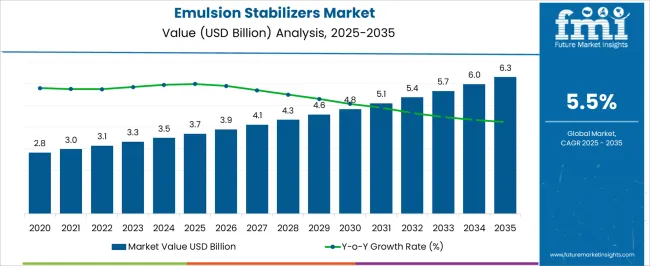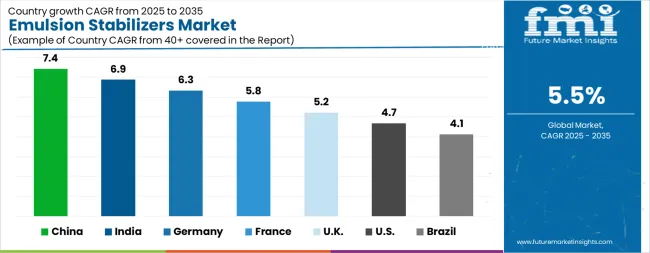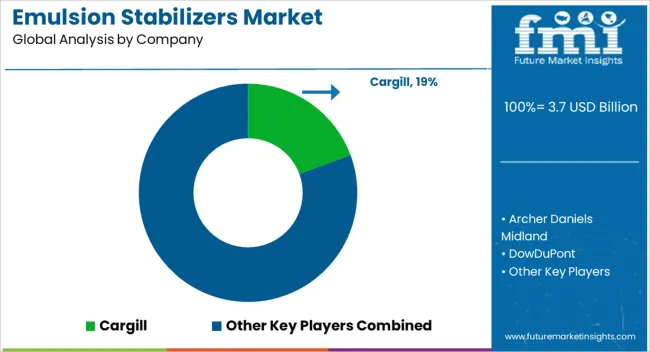The Emulsion Stabilizers Market is estimated to be valued at USD 3.7 billion in 2025 and is projected to reach USD 6.3 billion by 2035, registering a compound annual growth rate (CAGR) of 5.5% over the forecast period.

| Metric | Value |
|---|---|
| Emulsion Stabilizers Market Estimated Value in (2025 E) | USD 3.7 billion |
| Emulsion Stabilizers Market Forecast Value in (2035 F) | USD 6.3 billion |
| Forecast CAGR (2025 to 2035) | 5.5% |
The Emulsion Stabilizers market is experiencing steady growth driven by increasing demand from industries that rely on emulsified formulations to maintain product stability, performance, and consistency. In 2025, the market is witnessing significant adoption of advanced stabilizers that improve dispersion, reduce phase separation, and enhance product shelf life. The future outlook for this market is largely influenced by the ongoing growth of the textile, coatings, personal care, and industrial chemical sectors.
Investments in process efficiency, automation, and sustainable manufacturing practices are expected to further support market expansion. The rising need for high-performance emulsion stabilizers that are compatible with diverse chemical formulations is shaping the market’s trajectory.
Additionally, the growing focus on environmental sustainability and regulatory compliance is encouraging the use of biodegradable and low-toxicity stabilizers As manufacturers continue to prioritize product quality and stability while optimizing production costs, the Emulsion Stabilizers market is anticipated to witness continued adoption and innovation across key industrial sectors.
The emulsion stabilizers market is segmented by form, type, end use, and geographic regions. By form, emulsion stabilizers market is divided into Powder Emulsion Stabilizers, Solid Emulsion Stabilizers, Flakes Emulsion Stabilizers, and Liquid Emulsion Stabilizers. In terms of type, emulsion stabilizers market is classified into Xanthan Gum, Pectin, Carboxymethyl Cellulose, Gum Acacia, Starch, Gellan Gum, Propylene Glycol Alginate, and Diphosphates. Based on end use, emulsion stabilizers market is segmented into Food Industry, Beverage Industry, Personal Care & Cosmetics, and Pharmaceuticals. Regionally, the emulsion stabilizers industry is classified into North America, Latin America, Western Europe, Eastern Europe, Balkan & Baltic Countries, Russia & Belarus, Central Asia, East Asia, South Asia & Pacific, and the Middle East & Africa.
The Liquid Type Silicone material segment is projected to hold 49.60% of the Emulsion Stabilizers market revenue share in 2025, establishing it as the leading material type. This dominance is being driven by its superior ability to provide consistent emulsion stability, reduce foam formation, and enhance surface properties in end products. The segment’s growth has been supported by increasing adoption in textile, coatings, and personal care formulations, where product performance and aesthetic quality are critical.
Liquid Type Silicone stabilizers allow precise control over viscosity and dispersion, enabling formulators to maintain consistent quality even under varying production conditions. Additionally, the segment has benefited from rising awareness of performance advantages, such as improved texture, spreadability, and reduced phase separation, which are key requirements in industrial applications.
The ease of integration into existing production lines without extensive process modification has further reinforced its leadership As the demand for high-performance, cost-effective, and environmentally friendly stabilizers continues to rise, Liquid Type Silicone is expected to maintain its leading market position.
The Textile Industry application segment is expected to account for 46.80% of the Emulsion Stabilizers market revenue share in 2025, making it the largest end-use sector. This leadership is being driven by the rising demand for high-quality textile finishes, softeners, and coatings that require stable emulsions to ensure uniform application and enhanced fabric performance. The adoption of emulsion stabilizers in textile processes has been accelerated by the need for consistent product quality, reduced chemical wastage, and improved processing efficiency.
These stabilizers enable manufacturers to achieve desirable fabric softness, durability, and uniformity, which are critical for meeting consumer expectations. Additionally, growing investments in modern textile processing technologies and sustainable production practices have contributed to the increasing utilization of stabilizers in this sector.
The segment’s growth is further supported by the expansion of textile manufacturing in emerging regions and the adoption of automated finishing processes As textile production continues to modernize and demand for value-added fabrics rises, the application of emulsion stabilizers is expected to remain strong and continue driving market growth.
Emulsion stabilizers are one of the key ingredients consumed in very large scale in food, beverage, personal care & pharmaceutical industry for value addition or enhancement of the properties of the emulsion solution. The unique molecular structure of the emulsion stabilizers helps in reduction of the surface tension between lipophilic and hydrophobic molecules, thus helps in the formulation of the fine dispersed mixtures. Also, emulsion stabilizers enables the stability & extended shelf-life of the dispersion mixtures.
Emulsion stabilizers has been usually adopted in brews & drinks for the purpose of increasing shelf-life and looking after for taste and texture. Moreover, in the market place emulsion stabilizer is also used as a flavoring agent. Emulsion stabilizers are synthesized through both natural & synthetic medium out of which the emulsion stabilizers synthesize through natural medium are the preferred once in the market place.
Milk products like cheese, yogurt, to name a few requires exceptional properties so that it can withstand for more days with same nutritional value. Also, various personal care emulsions creams & pharmaceutical ointments are also come up with adequate level of emulsion stabilizers for increasing their numerous properties such as better binding properties, flow additives, viscosity modifier to name a few.
Some of the natural emulsion stabilizers in the commercial market are pectin, xanthan gum, starch & gellan gum among others. Petroleum based emulsion stabilizers are cost effective in nature and do show better properties for certain applications. Manufacturers present in the value chain are using mix of both natural & synthetic emulsion stabilizer formulation tailor-made according to the need of end-users.

| Country | CAGR |
|---|---|
| China | 7.4% |
| India | 6.9% |
| Germany | 6.3% |
| France | 5.8% |
| UK | 5.2% |
| USA | 4.7% |
| Brazil | 4.1% |
The Emulsion Stabilizers Market is expected to register a CAGR of 5.5% during the forecast period, exhibiting varied country level momentum. China leads with the highest CAGR of 7.4%, followed by India at 6.9%. Developed markets such as Germany, France, and the UK continue to expand steadily, while the USA is likely to grow at consistent rates. Brazil posts the lowest CAGR at 4.1%, yet still underscores a broadly positive trajectory for the global Emulsion Stabilizers Market. In 2024, Germany held a dominant revenue in the Western Europe market and is expected to grow with a CAGR of 6.3%. The USA Emulsion Stabilizers Market is estimated to be valued at USD 1.3 billion in 2025 and is anticipated to reach a valuation of USD 2.0 billion by 2035. Sales are projected to rise at a CAGR of 4.7% over the forecast period between 2025 and 2035. While Japan and South Korea markets are estimated to be valued at USD 167.2 million and USD 100.7 million respectively in 2025.

| Item | Value |
|---|---|
| Quantitative Units | USD 3.7 Billion |
| Form | Powder Emulsion Stabilizers, Solid Emulsion Stabilizers, Flakes Emulsion Stabilizers, and Liquid Emulsion Stabilizers |
| Type | Xanthan Gum, Pectin, Carboxymethyl Cellulose, Gum Acacia, Starch, Gellan Gum, Propylene Glycol Alginate, and Diphosphates |
| End Use | Food Industry, Beverage Industry, Personal Care & Cosmetics, and Pharmaceuticals |
| Regions Covered | North America, Europe, Asia-Pacific, Latin America, Middle East & Africa |
| Country Covered | United States, Canada, Germany, France, United Kingdom, China, Japan, India, Brazil, South Africa |
| Key Companies Profiled | Cargill, Archer Daniels Midland, DowDuPont, Ashland, Royal DSM, Tate & Lyle, CP Kelco, Ingredion, Fufeng Group, and Palsgaard A/S |
The global emulsion stabilizers market is estimated to be valued at USD 3.7 billion in 2025.
The market size for the emulsion stabilizers market is projected to reach USD 6.3 billion by 2035.
The emulsion stabilizers market is expected to grow at a 5.5% CAGR between 2025 and 2035.
The key product types in emulsion stabilizers market are powder emulsion stabilizers, solid emulsion stabilizers, flakes emulsion stabilizers and liquid emulsion stabilizers.
In terms of type, xanthan gum segment to command 38.4% share in the emulsion stabilizers market in 2025.






Our Research Products

The "Full Research Suite" delivers actionable market intel, deep dives on markets or technologies, so clients act faster, cut risk, and unlock growth.

The Leaderboard benchmarks and ranks top vendors, classifying them as Established Leaders, Leading Challengers, or Disruptors & Challengers.

Locates where complements amplify value and substitutes erode it, forecasting net impact by horizon

We deliver granular, decision-grade intel: market sizing, 5-year forecasts, pricing, adoption, usage, revenue, and operational KPIs—plus competitor tracking, regulation, and value chains—across 60 countries broadly.

Spot the shifts before they hit your P&L. We track inflection points, adoption curves, pricing moves, and ecosystem plays to show where demand is heading, why it is changing, and what to do next across high-growth markets and disruptive tech

Real-time reads of user behavior. We track shifting priorities, perceptions of today’s and next-gen services, and provider experience, then pace how fast tech moves from trial to adoption, blending buyer, consumer, and channel inputs with social signals (#WhySwitch, #UX).

Partner with our analyst team to build a custom report designed around your business priorities. From analysing market trends to assessing competitors or crafting bespoke datasets, we tailor insights to your needs.
Supplier Intelligence
Discovery & Profiling
Capacity & Footprint
Performance & Risk
Compliance & Governance
Commercial Readiness
Who Supplies Whom
Scorecards & Shortlists
Playbooks & Docs
Category Intelligence
Definition & Scope
Demand & Use Cases
Cost Drivers
Market Structure
Supply Chain Map
Trade & Policy
Operating Norms
Deliverables
Buyer Intelligence
Account Basics
Spend & Scope
Procurement Model
Vendor Requirements
Terms & Policies
Entry Strategy
Pain Points & Triggers
Outputs
Pricing Analysis
Benchmarks
Trends
Should-Cost
Indexation
Landed Cost
Commercial Terms
Deliverables
Brand Analysis
Positioning & Value Prop
Share & Presence
Customer Evidence
Go-to-Market
Digital & Reputation
Compliance & Trust
KPIs & Gaps
Outputs
Full Research Suite comprises of:
Market outlook & trends analysis
Interviews & case studies
Strategic recommendations
Vendor profiles & capabilities analysis
5-year forecasts
8 regions and 60+ country-level data splits
Market segment data splits
12 months of continuous data updates
DELIVERED AS:
PDF EXCEL ONLINE
Emulsion Polymers Market Size and Share Forecast Outlook 2025 to 2035
Emulsion Explosive Market Growth – Trends & Forecast 2025 to 2035
Stabilizers Market
Food Stabilizers Market Size and Share Forecast Outlook 2025 to 2035
Beer Stabilizers Market Size and Share Forecast Outlook 2025 to 2035
Evaluating Food Stabilizers Market Share & Provider Insights
Meat Emulsions Market Growth - Demand & Industry Insights 2025 to 2035
Heat Stabilizers Market Report - Growth & Forecast 2025 to 2035
Meat Stabilizers Blends Market Trends - Source & Function Analysis
Soil Stabilizers Market
Bakery Stabilizers Market Size and Share Forecast Outlook 2025 to 2035
Flavor Emulsions Market Size and Share Forecast Outlook 2025 to 2035
Marine Stabilizers Market Size and Share Forecast Outlook 2025 to 2035
Bakery Emulsions Market Analysis - Size, Share, and Forecast Outlook 2025 to 2035
Flavor Emulsion Market Analysis by Nature, End-Use, Distribution Channel, and Region - Growth, trends and forecast from 2025 to 2035
Polymer Stabilizers Market Size and Share Forecast Outlook 2025 to 2035
Acrylic Emulsions Market Size and Share Forecast Outlook 2025 to 2035
Bitumen Emulsion Plants Market Size and Share Forecast Outlook 2025 to 2035
Vaccine Stabilizers Market Analysis - Size, Share, and Forecast Outlook 2025 to 2035
Polymer Emulsions Market Size and Share Forecast Outlook 2025 to 2035

Thank you!
You will receive an email from our Business Development Manager. Please be sure to check your SPAM/JUNK folder too.
Chat With
MaRIA